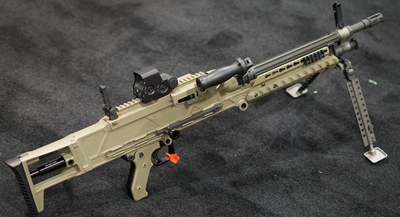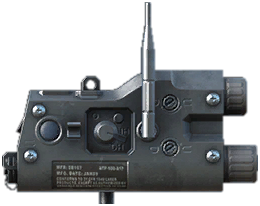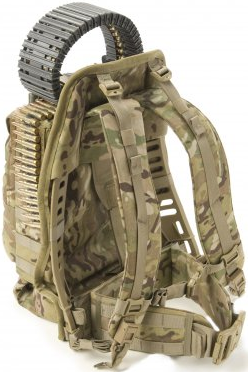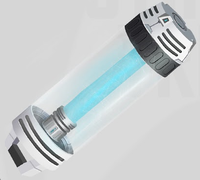No edit summary |
mNo edit summary |
||
| Line 1: | Line 1: | ||
[[File:M240ST.png|400px|thumb|An M240 ST on display, the platform for which the TR-240 ATWP was designed for.]] | |||
The <b>TR-240 Automated [[Transporter]] Weapons Package</b> is an upgrade kit designed for the M240 ST family of medium machine guns, originally inspired by [[Starfleet]] Security's TR-116 rifle and Lieutenant Chu'lak's serial killing spree, that consists of several devices that when combined, allow an M240 ST to act as an autonomously-targeting microtransporter-assisted smart weapon. M240 STs equipped with the upgrade package are designated <b>TR-240</b> or are colloquially referred to as <b>Smartguns</b> | The <b>TR-240 Automated [[Transporter]] Weapons Package</b> is an upgrade kit designed for the M240 ST family of medium machine guns, originally inspired by [[Starfleet]] Security's TR-116 rifle and Lieutenant Chu'lak's serial killing spree, that consists of several devices that when combined, allow an M240 ST to act as an autonomously-targeting microtransporter-assisted smart weapon. M240 STs equipped with the upgrade package are designated <b>TR-240</b> or are colloquially referred to as <b>Smartguns</b> | ||
Revision as of 15:09, 29 August 2017

The TR-240 Automated Transporter Weapons Package is an upgrade kit designed for the M240 ST family of medium machine guns, originally inspired by Starfleet Security's TR-116 rifle and Lieutenant Chu'lak's serial killing spree, that consists of several devices that when combined, allow an M240 ST to act as an autonomously-targeting microtransporter-assisted smart weapon. M240 STs equipped with the upgrade package are designated TR-240 or are colloquially referred to as Smartguns
Design
Full TR-240 upgrade kits are comprised of 5 different devices: a rail-mounted exographic target detector, an IFF transponder, an ammunition backpack, a microtransporter muzzle device, and some form of HUD display.
Target Detector

The exographic target detector, derived from that of the TR-116 rifle, is capable of visually penetrating through most types of surfaces, simultaneously feeding sensor data and imaging to the user's HUD while picking out all lifeforms within a 270-degree cone in front of the weapon's muzzle. The sensor features an adjustable range function to reduce HUD clutter during short range engagements, and has an effective range coinciding with that of the M240 ST's at around 1100 meters, although targets are incredibly difficult to discern from outdoor background clutter past 400 meters and indoor clutter past 90 meters. Effectively, the target detector serves as the eyes of the weapon, and feeds data to all but one of the system's components. Due to the multiple mode options and the longer range of the device, it cannot be mounted to the head like that of the TR-116's, and must be mounted on the side rail.
In the event that lifeforms are not recognized by the exographic sensor, the sensor features both a thermal imaging secondary mode and a direct line-of-sight motion sensor tertiary mode.
IFF Transponder

The IFF transponder used for the TR-240 kit is a simple device that computes the targeting data fed to it from the exographic sensor before sending out strong radio pulses towards confirmed lifeforms detected by the sensor. These pulses match with the IFF transponder inside each Solas Tempus Communicator, and if a positive tone is received back, usually instantaneously, the target is marked as friendly by the system. Invalid or no pulses back from an individual being pinged enable the microtransporter system to lock onto them, which presents a problem when used in civilian areas or around ST-affiliated personnel without communicators as the transponder does not confirm targets as hostile.
Microtransporter Unit

Attached to the muzzle of TR-240s is a threaded, shielded microtransporter unit, capable of transporting small objects of up to about 20 grams in mass. Taking target orientation, range, and obstacle information from the exographic target detector as well as input from the IFF transponder, the microtransporter system is cued to the user's HUD device and allows them to achieve a transporter lock onto any non-confirmed friendly lifeforms that they look at. Once a transporter lock is confirmed, the user's targeting reticule will turn red, which in turn signals the operator that they may begin firing. When a round is fired and finishes traveling down the entire barrel, thus gaining as much velocity as it can, it is dematerialized by the microtransporter and rematerialized about 10 centimeters in front of the target's mid-anterior side, where it will continue it's forwards course into the target. Similar to the modified TR-116 rifle used by Lieutenant Chu'lak, the microtransporter effectively allows an M240 ST operator to shoot enemies through walls, with the same effectiveness out to the exographic sensor's maximum range of 1,100 meters. Being an instantaneous process, the high-velocity M118 AP-FMJ rounds used in such a manner are just about impossible to dodge.
The transporter is capable of locking onto up to 8 targets at a time, allowing the operator to engage them in succession. The attachment features an external bar connecting to the 240's safety switch, and if there is no solid lock, the weapon will not fire unless the transporter is toggled off and the safety is manually disengaged.

An unintended side effect of using the microtransporter system is that the support gunner no longer has to fire while exposing themself to the enemy, and can even fire it directly behind friendly personnel without harming them. The transporter lock remains on a target until a new target is acquired or it is otherwise dismissed.
There is a cutout at the end of the muzzle as well as a recessed power switch on the side of the transporter, allowing for manual use should the transporter be jammed in any fashion.
HUD unit
In order to properly display sensor imaging and readouts, as well as the microtransporter's targeting reticule, the TR-240 requires a HUD-compatible device of some origin. These can range anywhere from security eyepieces to Tal Ravis' modified goggles to Class 1K and 1M exosuit helmets. Typically, the larger the HUD surface area, the easier it is to use the weapon, as it can be otherwise difficult to discern between sensor readout, imaging, and the lock reticule.
Ammunition Backpack
While not an integral component of the TR-240 package, all kits come with a 500-round, plasticized tritanium mesh-reinforced ammunition backpack, consisting of a hardened, armored backpack and a long feed chute that attaches to the weapon, allowing for up to 500 rounds to be stored safely and in one continuous disintegrating metal belt. The feed chute has slits cut along it for flexibility, and does not have to be attached to the weapon to function. As such, some gunners take a larger ammo load of 550 rounds, using the first 50 rounds to establish fire superiority and moving to short bursts afterwards once the drooping belt catches up to the feed chute.
Disadvantages
- "The more they overthink the plumbing, the easier it is to stop up the drain!"
- —Montgomery Scott

There are several key disadvantages to the TR-240 system that prevent it from seeing widespread acceptance in Solas Tempus service.
The first of these is weight and bulk, as the target detector, IFF transponder, and microtransporter weigh about 10 pounds combined, thus increasing the weight of the M240 ST to almost 30 pounds unloaded. While the weight of the backpack varies with ammunition load, the entire system is considerably heavier than any other infantry weapon employed by Solas Tempus, bar semi-mobile phaser cannons and some variants of the Mark 1 Railgun. On the flip side, the need to aim and provide accurate fire is reduced entirely, assuming the weapon system is functioning, and the operator only really has to be capable of carrying it all.
Endurance is perhaps the largest issue, as in addition to the weight bearing down on those going on patrols or extended missions, the target detector, transponder, and transporter each have their own separate power cells, which are small, delicate items that aren't easily exchangable in field conditions. The maximum endurance of the TR-240 system is 8 hours, although operators may begin seeing issues with sensor output as early as 5 hours into an operation.
In crowded areas, especially during temporal missions, the TR-240's IFF transponder will identify friendlies, but will mark all those it does not recognize as friendly as unknown, as it cannot confirm foe status. This can lead to issues with collateral damage, especially at longer ranges where targets are harder to discern from background clutter and one another.
Additionally, the finnicky nature of the microtransporter and sensor array means that properly shielded targets cannot be locked on to, although the transporter can be remodulated to match shield harmonics. Early versions of the microtransporter muzzle attachment, taken as exact copies of the TR-116's, had a tendency to shake themselves apart during sustained automatic fire as they weren't designed to handle the pressure and muzzle blast of a high-powered automatic weapon. While this has been remedied somewhat, the inner barrel liner of the microtransporter must be replaced after 3000 rounds, lest it break and potentially damage the microtransporter unit itself.
It is not a stealthy weapon, either, despite the nature of engagements, as while the bullet is transported away, the gasses, blast, and flash remain, making it hard to conceal without a lengthy, heavy sound suppressor. Additionally, as there is no flash suppressor, the operator can be temporarily blinded when firing in dark areas or at nighttime, on top of revealing their position.
The last major concern is effective range, as the sensor can only really see targets at 400 meters (outdoors) and 90 meters (indoors). This is lower than most infantry arms employed by Solas Tempus, with the exception of some personal handguns.